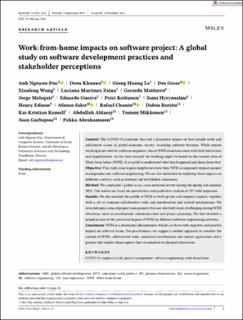| dc.contributor.author | Nguyen, Anh Duc | |
| dc.contributor.author | Khanna, Dron | |
| dc.contributor.author | Le, Giang Huong | |
| dc.contributor.author | Greer, Des | |
| dc.contributor.author | Wang, Xiaofeng | |
| dc.contributor.author | Zaina, Luciana Martinez | |
| dc.contributor.author | Matturro, Gerardo | |
| dc.contributor.author | Melegati, Jorge | |
| dc.contributor.author | Guerra, Eduardo | |
| dc.contributor.author | Kettunen, Petri | |
| dc.contributor.author | Hyrynsalmi, Sami | |
| dc.contributor.author | Edison, Henry | |
| dc.contributor.author | Sales, Afonso | |
| dc.contributor.author | Chanin, Rafael | |
| dc.contributor.author | Rutitis, Didzis | |
| dc.contributor.author | Kemell, Kai-Kristian | |
| dc.contributor.author | Aldaeej, Abdullah | |
| dc.contributor.author | Mikkonen, Tommi | |
| dc.contributor.author | Garbajosa, Juan | |
| dc.contributor.author | Abrahamsson, Pekka | |
| dc.date.accessioned | 2024-02-02T07:46:39Z | |
| dc.date.available | 2024-02-02T07:46:39Z | |
| dc.date.created | 2024-01-11T10:38:43Z | |
| dc.date.issued | 2023 | |
| dc.identifier.citation | Software, Practice & Experience. 2023, 1-31. | en_US |
| dc.identifier.issn | 0038-0644 | |
| dc.identifier.uri | https://hdl.handle.net/11250/3115167 | |
| dc.description.abstract | Context: The COVID-19 pandemic has had a disruptive impact on how people work and
collaborate across all global economic sectors, including software business. While remote
working is not new for software engineers, forced WFH situations come with both limitations
and opportunities. As the ‘new normal’ for working might be based on the current state of
Work-from-home (WFH), it is useful to understand what has happened and learn from that.
Objective: This study aims to gain insights into how their WFH arrangement impacts project
management and software engineering. We are also interested in exploring these impacts in
different contexts, such as startups and established companies.
Method: We conducted a global-scale, cross-sectional survey during the spring and summer
2021. Our results are based on quantitative and qualitative analysis of 297 valid responses.
Results: We characterize the profile of WFH in both spatial and temporal aspects, together
with a set of common collaborative tools and coordination and control mechanisms. We
revealed some areas of project management that are relatively more challenging during WFH
situations, such as coordination, communication and project planning. We also revealed a
mixed picture of the perceived impact of WFH on different software engineering activities.
Conclusion: WFH is a situational phenomenon which can have both negative and positive
impact on software teams. For practitioners, we suggest a unified approach to consider the
context of WFH, collaborative tools, associated coordination and control approaches and a
process that resolve those aspects that are sensitive to physical interaction. | en_US |
| dc.language.iso | eng | en_US |
| dc.rights | Navngivelse-Ikkekommersiell 4.0 Internasjonal | * |
| dc.rights.uri | http://creativecommons.org/licenses/by-nc/4.0/deed.no | * |
| dc.title | Work-from-home impacts on software project: A global study on software development practices and stakeholder perceptions | en_US |
| dc.type | Peer reviewed | en_US |
| dc.type | Journal article | en_US |
| dc.description.version | publishedVersion | en_US |
| cristin.ispublished | true | |
| cristin.fulltext | original | |
| cristin.qualitycode | 1 | |
| dc.identifier.doi | 10.1002/spe.3306 | |
| dc.identifier.cristin | 2224403 | |
| dc.source.journal | Software, Practice & Experience | en_US |
| dc.source.pagenumber | 1-31 | en_US |

